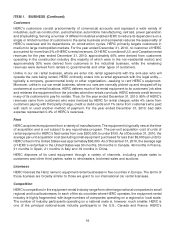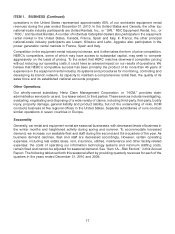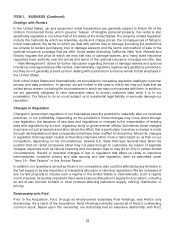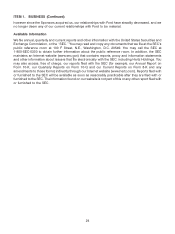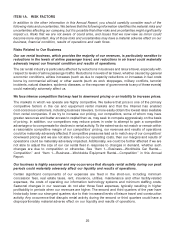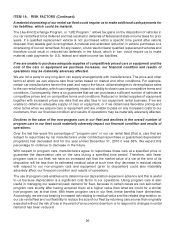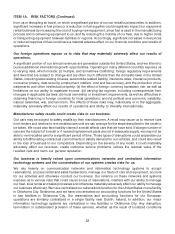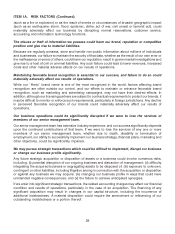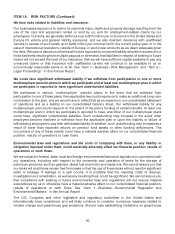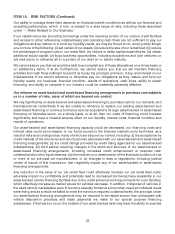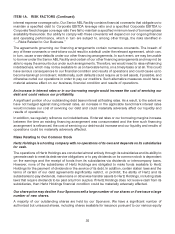Hertz 2010 Annual Report Download - page 50
Download and view the complete annual report
Please find page 50 of the 2010 Hertz annual report below. You can navigate through the pages in the report by either clicking on the pages listed below, or by using the keyword search tool below to find specific information within the annual report.ITEM 1A. RISK FACTORS (Continued)
A material downsizing of our rental car fleet could require us to make additional cash payments for
tax liabilities, which could be material.
The Like-Kind Exchange Program, or ‘‘LKE Program,’’ allows tax gains on the disposition of vehicles in
our car rental fleet to be deferred and has resulted in deferrals of federal and state income taxes for prior
years. If a qualified replacement vehicle is not purchased within a specific time period after vehicle
disposal, then taxable gain is recognized. A material and extended reduction in vehicle purchases or a
downsizing of our car rental fleet, for any reason, could result in fewer qualified replacement vehicles and
therefore could result in reduced tax deferrals in the future, which in turn could require us to make
material cash payments for U.S. federal and state income tax liabilities.
If we are unable to purchase adequate supplies of competitively priced cars or equipment and the
cost of the cars or equipment we purchase increases, our financial condition and results of
operations may be materially adversely affected.
We are not a party to any long-term car supply arrangements with manufacturers. The price and other
terms at which we can acquire cars thus varies based on market and other conditions. For example,
certain car manufacturers have in the past, and may in the future, utilize strategies to de-emphasize sales
to the car rental industry, which can negatively impact our ability to obtain cars on competitive terms and
conditions. Consequently, there is no guarantee that we can purchase a sufficient number of vehicles at
competitive prices and on competitive terms and conditions. Reduced or limited supplies of equipment
together with increased prices are risks that we also face in our equipment rental business. If we are
unable to obtain an adequate supply of cars or equipment, or if we obtain less favorable pricing and
other terms when we acquire cars or equipment and are unable to pass on any increased costs to our
customers, then our financial condition and results of operations may be materially adversely affected.
Declines in the value of the non-program cars in our fleet and declines in the overall number of
program cars in our fleet could materially adversely impact our financial condition and results of
operations.
Over the last few years the percentage of ‘‘program cars’’ in our car rental fleet (that is, cars that are
subject to repurchase by car manufacturers under contractual repurchase or guaranteed depreciation
programs) has decreased and for the year ended December 31, 2010 it was 55%. We expect this
percentage to continue to decrease in the future.
With respect to program cars, manufacturers agree to repurchase these cars at a specified price or
guarantee the depreciation rate on the cars during a specified time period. Therefore, with fewer
program cars in our fleet, we have an increased risk that the market value of a car at the time of its
disposition will be less than its estimated residual value at such time. Any decrease in residual values
with respect to our non-program cars and equipment (prior to disposition) could also materially
adversely affect our financial condition and results of operations.
The use of program cars enables us to determine our depreciation expense in advance and this is useful
to us because depreciation is a significant cost factor in our operations. Using program cars is also
useful in managing our seasonal peak demand for fleet, because in certain cases we can sell certain
program cars shortly after having acquired them at a higher value than what we could for a similar
non-program car at that time. With fewer program cars in our fleet, these benefits have diminished.
Accordingly, we are now bearing increased risk relating to residual value and the related depreciation on
our car rental fleet and our flexibility to reduce the size of our fleet by returning cars sooner than originally
expected without the risk of loss in the event of an economic downturn or to respond to changes in rental
demand has been reduced.
26


